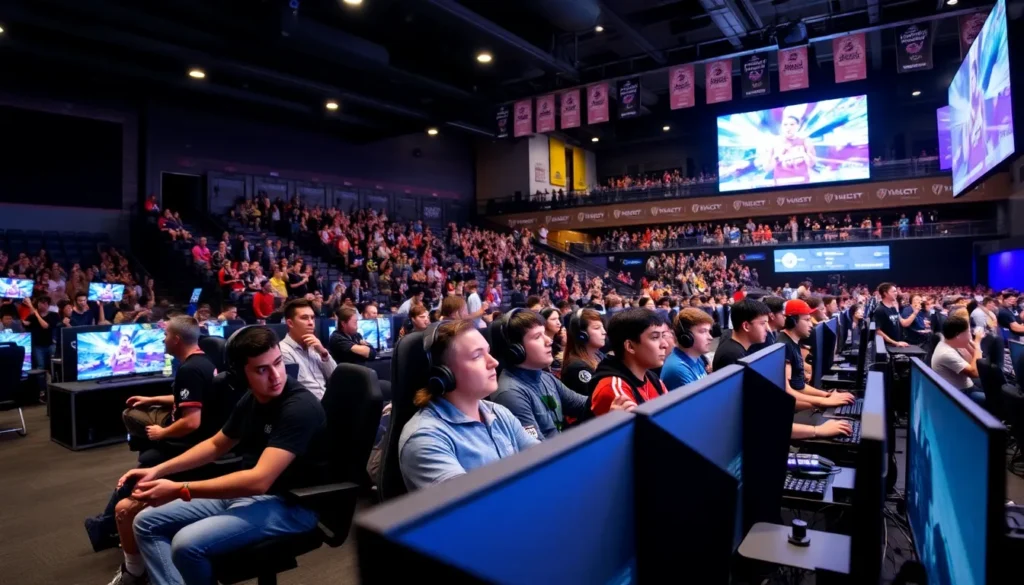Table of Contents
ToggleImagine stepping into a world where you can shoot laser beams, race cars, or even dance with dragons without leaving your living room. Welcome to the thrilling universe of VR gaming. In recent years, virtual reality has transformed from a sci-fi dream into a thriving industry that keeps players on the edge of their seats. Today, we investigate into the dynamic landscape of VR gaming companies that are shaping this exciting frontier. With humor and insight, let’s uncover what makes these companies tick and where virtual reality might take us next.
The Evolution of VR Gaming

Virtual reality gaming has come a long way since its formative days in the 1990s. It all kicked off with rudimentary headsets and clunky software that was more novelty than immersive. Remember those arcade machines that promised a ‘VR experience’? Fast forward to today, and it’s like comparing a flip phone to a smartphone.
With the advent of advanced technologies like motion tracking, 3D audio, and responsive hardware, the last decade has witnessed an explosion in creativity. Companies are pushing boundaries, crafting experiences that are incredibly immersive, to the point where players lose themselves in fantastical worlds.
From the days of the Virtuality Group’s arcade systems to the rise of powerful consumer headsets like the Oculus Rift and HTC Vive, the evolution is nothing short of remarkable. Gamers can now interact with their environments like never before, which means the future is only going to get brighter.
Key Players in the VR Gaming Industry
When it comes to VR gaming, a few companies are leading the charge. Oculus, owned by Meta Platforms, has set a high bar with its Quest line of headsets, enabling untethered gameplay that’s surprisingly accessible. Meanwhile, Sony has entered the fray with its PlayStation VR, appealing to console gamers who want a taste of virtual reality.
Valve’s Index headset is also worth mentioning. Known for its high fidelity and premium price tag, the Index attracts hardcore enthusiasts who crave the very best. Each of these companies contributes to the expanding universe of VR gaming, and together they’re crafting the experiences that will define the next generation of gamers.
Innovative Technologies Shaping VR Gaming
Behind the scenes of thrilling VR worlds lies a treasure trove of cutting-edge technologies. Companies are harnessing innovations like eye-tracking, haptic feedback, and even AI to create experiences that are not only immersive but also deeply interactive.
Eye-tracking technology allows games to respond to where a player is looking, enhancing realism by enabling subtle interactions. This means instead of just looking at an object, players can influence it with their gaze. On the other hand, haptic feedback is revolutionizing how players experience sensations, turning virtual actions into physical responses. Imagine feeling the rumble of a sword clash or the gentle breeze in a peaceful forest.
Add to the mix advancements in graphics and sound design, and you have a recipe for unmatched virtual engagement. Each technological leap not only enhances gameplay but also opens up new avenues for storytelling and player interaction.
Popular VR Games and Their Developers
As for the games, they vary widely, encompassing genres from thrilling shooters to serene adventures. Titles like “Half-Life: Alyx” have set the standard for storytelling in VR, brilliantly showcasing how games can deliver narratives while using the medium’s strengths. Developed by Valve, it’s a benchmark in quality and engagement that many aspire to emulate.
Then there’s “Beat Saber”, an addictive rhythm game that has taken the VR world by storm. Developers at Beat Games have created a phenomenon, turning ordinary players into lightsaber-wielding rock stars.
Not to forget giants like “The Walking Dead: Saints & Sinners” by Skydance Interactive that immerse players in narrative-rich experiences complete with heart-pounding action. Each game reflects the creative ambition and technological prowess of VR development.
Future Trends in VR Gaming Companies
Looking ahead, the future for VR gaming companies is filled with exciting possibilities. As technology continues to evolve, we can expect greater levels of realism and increased accessibility. Innovations like wireless headsets and cloud gaming could break the barriers that currently restrict user access.
Also, social interaction is likely to play a significant role. Picture virtual concerts, multiplayer adventures, or even educational experiences that foster community and learning. The potential for shared experiences is endless, creating new connections in virtual spaces. Think of it as a ‘virtual coffee shop’ where friends can meet and interact without the hindrance of physical distance.
As the industry grows, stay tuned for startups that are bound to emerge with fresh ideas, adding fuel to an already blazing fire. The VR gaming landscape might evolve in ways we can’t yet imagine.
Challenges Facing the VR Gaming Industry
Even though the promising horizon, challenges loom large for the VR gaming industry. High costs and the need for powerful hardware can be deterring factors for potential players. Not everyone wants to shell out for an advanced headset and powerful gaming rig, after all.
Besides, the content catalog often struggles to keep pace with consumer expectations. Gamers want engaging, diverse, and high-quality titles, but the development cycle for VR titles can be lengthy and resource-intensive. It’s a balancing act that companies must navigate.
Let’s not overlook user discomfort. Some players experience motion sickness or fatigue during gameplay, which can limit the audience. Continuous efforts to make gaming experiences smoother and more comfortable are essential as VR companies refine their technologies.







